Neil Peart's News, Weather and Sports
Backstage Byways
NeilPeart.net, June 14, 2015
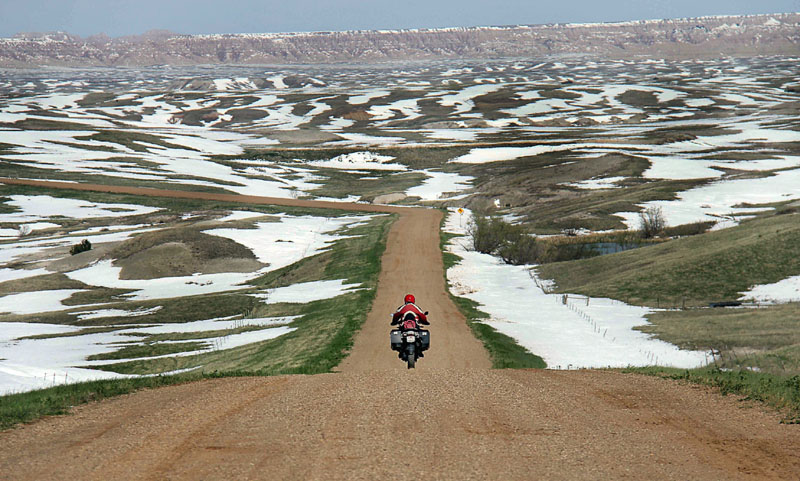
Two riders were approaching (nice accidental quote from "All Along the Watchtower") the back way into Badlands National Park, South Dakota, on May 11, 2015. As shown by the surrounding snow, it was cold-below freezing that morning when Michael and I got off the bus at the Chateau Walmart in Ogallala, Nebraska. As we rode north, snow lay in intricate patchworks over the geology of an ever-changing landscape, and the temperature barely crept into the forties.
Still, we were dressed for it, and the roads were plowed and dry. The freak snowfall was a rare decoration for the many riding photographs we took across the Sand Hills of Nebraska into the Black Hills and the Badlands of South Dakota.
Just to exist in this pictured moment-to be riding on that gravel road through that artfully snow-laced landscape-was part of a day's campaign that had to be planned and executed with military precision.
It began the previous afternoon, with me crouched on the floor of the bus in Lincoln, Nebraska, amid a tapestry of paper maps. After our show there we had a day off before the next one in St. Paul, Minnesota, and I had a large area of possible exploration between. I began by glancing over the "regional" map of the Central States, for the bird's-eye view. Sometimes I even started by scanning the opening pages in the road atlas (the Book of Dreams) that displayed the entire country-helpful for the "meta" planning, including looking at other cities we would be performing in, to divide up my "areas of exploration." For example, I might be thinking, "We'll head west tomorrow-save the Mormon Garden of Eden for Kansas City." (No joke-you'll see!) Then I would go to the more-detailed state maps to find the smallest roads through the most "interesting" areas and possible overnight stops.
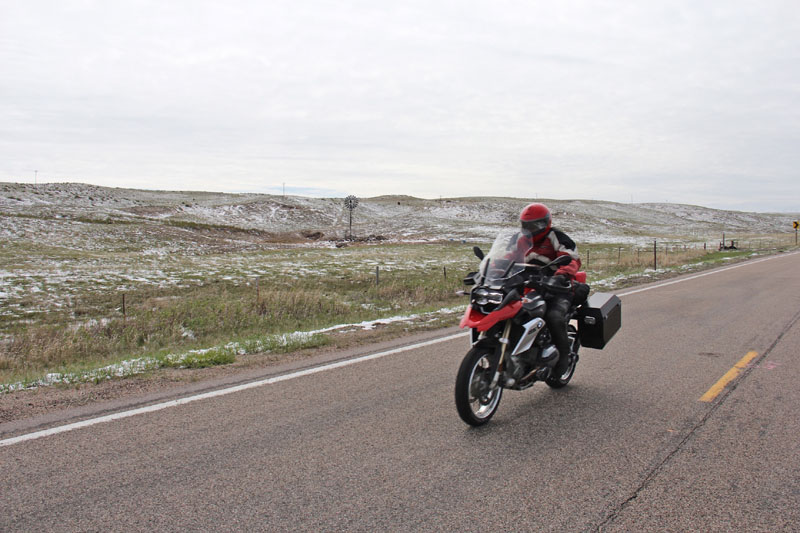 |
Frosted Nebraska |
("Interesting" is subjective, of course. An early writing teacher, Mark Riebling, said I should never use the words "beautiful" or "interesting"-because they were meaningless to anyone who didn't know what might be beautiful or interesting to me. I have always tried to follow that advice, but it seems permissible with quotation marks.)
In recent years those paper maps are increasingly hard to find. We used to start every tour by buying the Rand McNally boxed set of all fifty states, but now Michael has to collect them piecemeal online, and they are dated more than a decade ago.
Perhaps it is only long habit that makes me prefer to find my routes on paper maps, with the tactile details they seem to reveal-and that's the perfect word. I do not so much design a route as study the page for a while and let the "right" roads be revealed to me. With highlighter pen, I stitch together a complicated thread of Rand McNally's thin red lines, gray lines, and best of all, the broken gray lines-the unpaved roads. The term "adventure riders" has become tarnished with overuse, but if it's adventure a motorcyclist is looking for, it will likely be found on those roads.
Unless we have to get into a city for work, I avoid all major arteries, especially divided four-lanes (heavy traffic, low speed limits, and frequent intersections), and any settlements with more than a single stoplight or two. Once I have joined the puzzle (as it often feels) with my blue highlighter, we move into the modern digital world. I pass the map to Michael and, kneeling at his computer, he transfers the route (often with much mumbling of profanities) to his mapping program, "Mother." She sometimes dislikes those broken gray lines, and won't let Michael place the route there-keeps ignoring my desires, and the paper map's information, and offering her own "interpretation." Michael will warn me that we have some "mystery roads" coming up. The routes are downloaded to our onboard units (called Doofus and Dingus since we first started using GPS, in 2004, and even in their fifth generation still often earn their names).
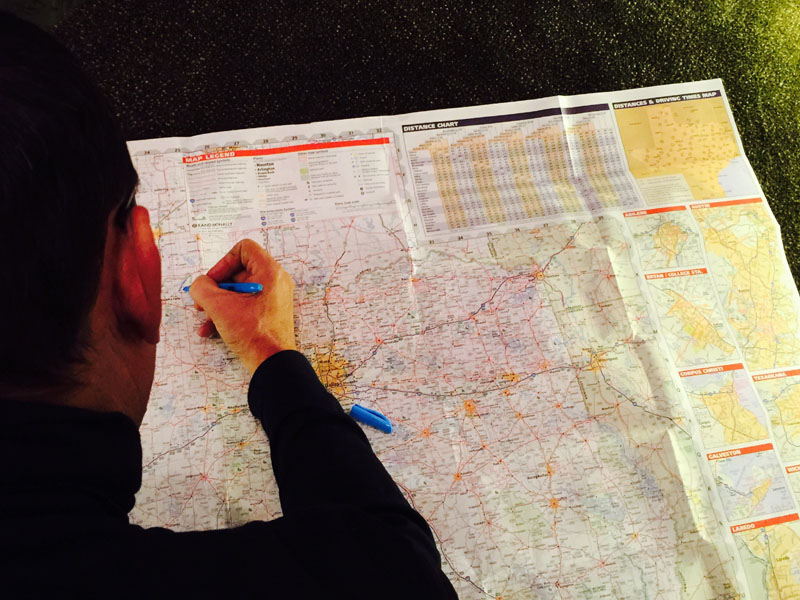 |
Pathfinder |
In this photo I am starting to draw the Texas portion of a route to carry us from a dropoff point at a Chateau Walmart near Oklahoma City toward the next show in Austin, Texas. At that very moment I was contemplating possible ways to sneak around Wichita Falls-too big to get caught up in, but like many "hub" towns, most nearby roads were magnetically drawn to it. I was considering Abilene, Texas, as a possible overnight destination (emphasis always on possible-reflecting the best church sign ever: "Want To Make God Laugh? Tell Him Your Plans." I wouldn't give him the satisfaction). Abilene appealed for the usual mix of reasons-big enough to have motels and restaurants, small enough to get into and out of easily, and... a pretty name.
A week or so before that photo, I was in the same position, contemplating the day off between Lincoln and St. Paul. Scanning the map around and between those points, my eyes immediately went to western South Dakota and its many attractions. Not that it was anything like "around and between those points," but it might be doable, with a little strategy.
Brutus and I had ridden through that area on the Test for Echo tour, in 1996-'97-almost twenty years before. I laughed and told Michael how back then Brutus and I had been planning a ride from Durango, Colorado, where our wives had joined us on a break to explore the Four Corners region together, to the next show in Cincinnati. Looking over the map (the big one of the whole country that time!), I pointed to Mount Rushmore and asked Brutus if he thought we could make it there "on the way."
Of course it was anything but "on the way"-it would add 500 miles to a journey that was already 1,500 miles, and we only had four days to get to that show in Cincinnati.
But, Brutus being Brutus, he nodded and said we could do it. Me being me, I said, "Let's." The highlight of that cross-country ride remained the area around the Black Hills-the spectacular sight of Mount Rushmore, a stop at the memorial of Wounded Knee, and crossing the Badlands, all remained powerful in memory. I wanted to see them again-but this time too the ambition could truly be defined as "a long shot."
It would also require some help from bus driver Dave (with me for all those nineteen years since Test for Echo).
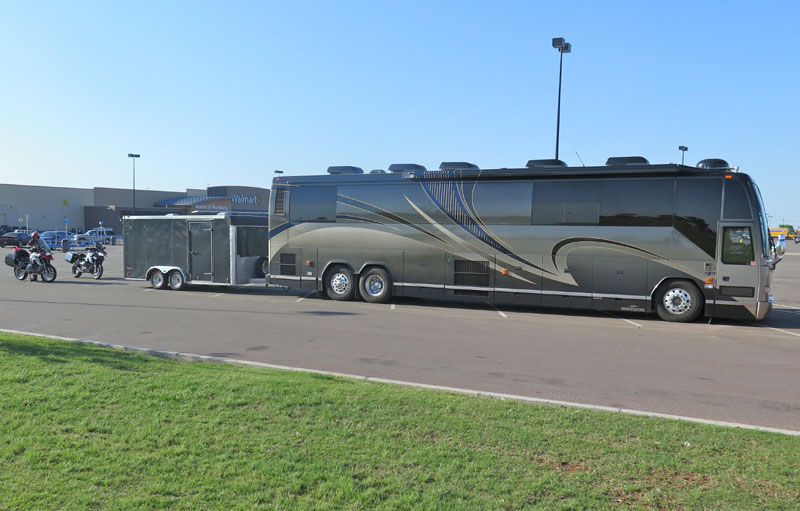 |
Chateau Walmart Morning |
After our shows I run straight to the bus with Michael, and Dave starts driving. While I get changed, have a drink and a sandwich, then look over the photographs from the previous few days, Dave delivers us to the designated dropoff point. Truckstops are increasingly crowded and noisy, while Walmart parking lots welcome overnight campers (potential morning shoppers), so that is often our choice. I try to plan the drives to be three hours or so-so that by the time I'm ready to go to bed, the bus will be parked.
My journal note from the first show in Tulsa:
Show report-after all that preparing. Pretty good overall, except for two hardest bits, in "Headlong" and "Monkey Biz."
Made it through, anyway, in every sense.
Feeling pretty good about everything right now.
It cannot last ...
Thus spake a man well versed, and sometimes cursed, in performing, travel, and life. Remember that church sign again, and this pilgrim has endured enough of God's laughter in sixty-two-point-five years-what I call my "Metric Century." (Because in long-distance bicycling a major goal is a Century, a hundred miles in one day, but sometimes less ambitious-or less masochistic-cyclists choose what is called a Metric Century, a hundred kilometers [please say "kill-o-meters"], or sixty-two-point-five miles.) So if there's anything I've learned in my Metric Century, it's not to tell anybody my plans! (Or my failures.)
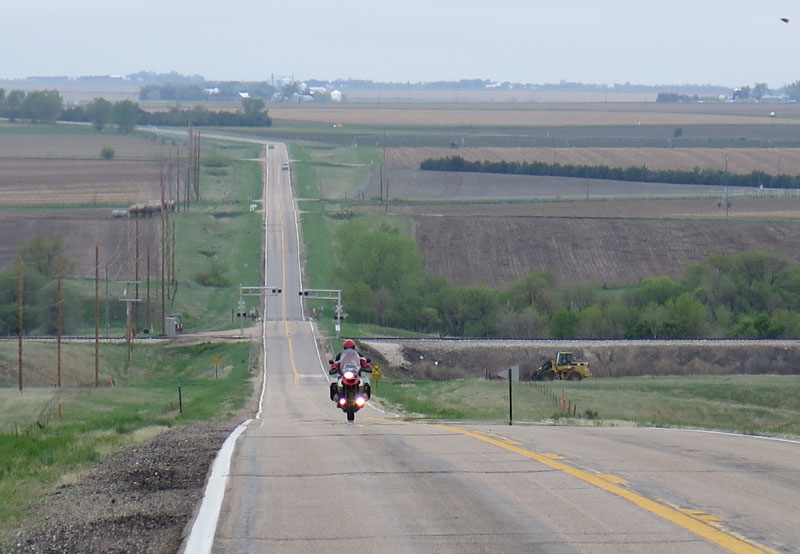 |
Rainy Nebraska |
Sometimes a motorcycling destination is worth a longer bus ride, and a bouncier sleep. Other times circumstances force it. On the day of the Tulsa show, while checking over my motorcycle, I discovered a bind in the back wheel, like the brake caliper dragging on the disc. My mechanical abilities are pretty much limited to oil changes (though I'm very good at those!), so it would need to be taken to a BMW dealer. Fortunately there was one in Omaha, near the next show in Lincoln, and Michael called ahead to let them know we'd be bringing it in. I transferred my tools and such to the spare bike (the older GS that usually lives at my home in Quebec), and drew up a plan that would get Dave close enough to Omaha, while Michael and I could head west across Nebraska.
Dave drove us north most of the night, to York, Nebraska, and once Michael and I were up and away, he continued to the BMW dealer in Omaha (thanks to them for excellent service and delivery!).
Rain and cold shrouded us across Nebraska and back-the rare day that actually got colder through the afternoon, from the chilly mid-fifties to the positively frosty mid-forties. (Wind chill at fifty mph well below freezing.) The above landscape, captured between showers and thunderstorms, is not as "picturesque" as most I would choose, but it feels "evocative." The narrow two-lane over a gently rolling landscape ("hummocky," I called it in my journal), the sprays of early-summer green along the roadside and the cottonwoods in the draw (always wanted to use that phrase), the brown contours of the freshly-tilled-and-planted fields, the railroad crossing, the science-fiction farm buildings in the distance, the bleak gray sky. There are even a few center-pivot irrigation rigs (long silvery trusses on wheels)-a device that puzzled Brutus and me in our early travels in that area: "How do it work?" The two cars also represent the heaviest traffic we encountered that day, until we had to get through Lincoln to the arena.
The Lincoln show was a little better than the one in Tulsa, but still marred by a few rough spots-it would not be until the third show, in St. Paul, that I thought we hit our groove. (That was just the internal critic, of course-in every case the audiences were cheering and happy, and that was exhilarating. Friend Matt Scannell attended the St. Louis show with some friends, and reported that on the way out "strangers were high-fiving each other." Nice.)
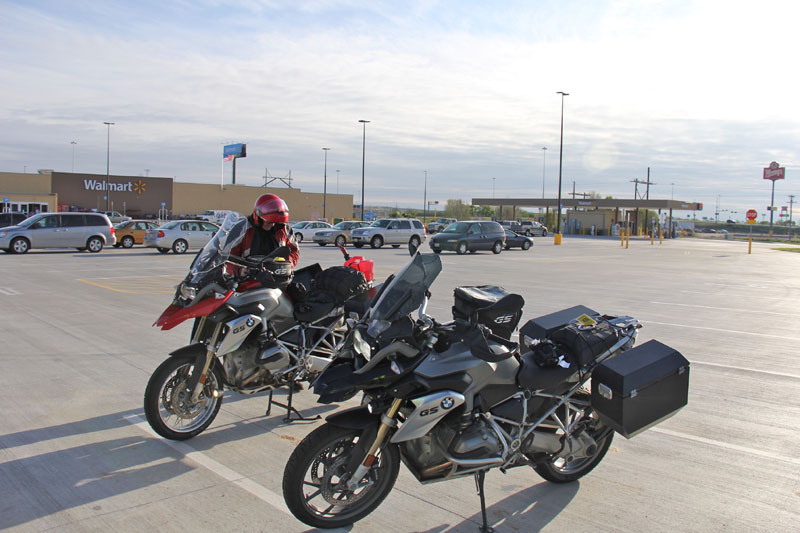 |
Ogallala Walmart, Morning Shadows |
Later Dave drove us west through most of the night, then parked us at the Chateau Walmart in Ogallala, Nebraska. Despite never getting to sleep after a show until about one a.m., I set my alarm for a painful seven o'clock (again, uncomfortable but worth it). Dragging myself out of bed, I turned on the coffeepot (preloaded by Dave), and sliced and squeezed the oranges into the electric juicer, then into the glasses frosting in the freezer overnight. After a few minutes of quiet time with juice and coffee, looking out the bus window at the day's weather and early Walmart shoppers (justly famous on the interweb), I went back to wake Michael-with the usual rattle of the curtains over his bunk, and a grunt quiet enough not to wake Dave, earplugged in the bunk below. Michael responded with an echoed grunt, and we had "communicated."
After some cereal and bananas, and another cup of coffee, we started suiting up-wearing every layer we owned. We also had electrically-heated vests-though a moral dilemma arose when I lent my spare one to Michael, only to discover that his worked, but mine didn't. What do you do in a situation like that? If you're like me, you shut up and accept it. If you're like Michael, you keep moaning dramatically at every stop about how cold you are-all except for the part the vest warms. (So your body, then.)
I had been watching the weather carefully, and knew it would be cold, and that significant snow had fallen in the Rapid City area. Thus I was prepared for my plans to be stymied that way, and would adapt as necessary. (That church sign again, coupled with the eternal gospel from my late drum teacher Freddie Gruber, "It is what it is. Deal with it.")
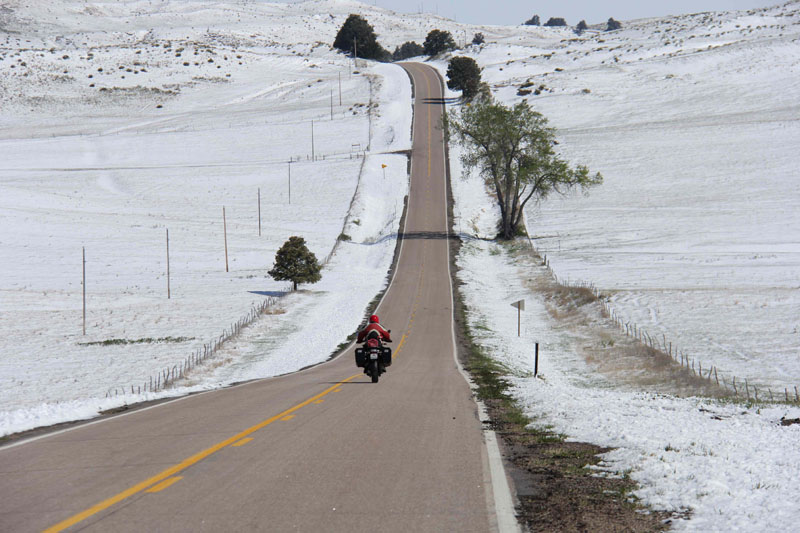 |
This Too Is Nebraska |
In past years I had ridden through part of the Sand Hills of Western Nebraska, and remembered the area as desolately pretty and surprisingly dynamic. Like the backroads of western Idaho or central Missouri, say-not that many turns, but lots of ups and downs, the pavement laid like a ribbon over the undulations. On that unseasonably wintry morning in mid-May, the snow was at least...picturesque.
My first target was Wounded Knee, South Dakota, at the humble monument where Brutus and I had stopped all those years ago. The sad histories of Native Americans and Canadians had attracted my sympathy and interest for many years, and Dee Brown's Bury My Heart at Wounded Knee: An Indian History of the American West (1970) remains one of the important works. I was pleased to learn from my friends at Wikipedia that "the title is taken from the final phrase of a twentieth-century poem titled 'American Names' by Steven Vincent Benet. The full quotation, 'I shall not be there, I shall rise and pass/ Bury my heart at Wounded Knee,' appears at the beginning of Brown's book. Although Benet's poem is not about the plight of Native Americans, Wounded Knee was the location of the last major confrontation between the US Army and Native Americans."
That final phrase bleeds tragedy and shame, and the interested reader is encouraged to seek out Dee Brown's book. (Driver Dave is also keen on early American history, especially of the West, and both having read that book many years ago, we agreed that we wanted to read it again now, knowing so much more of its context.)
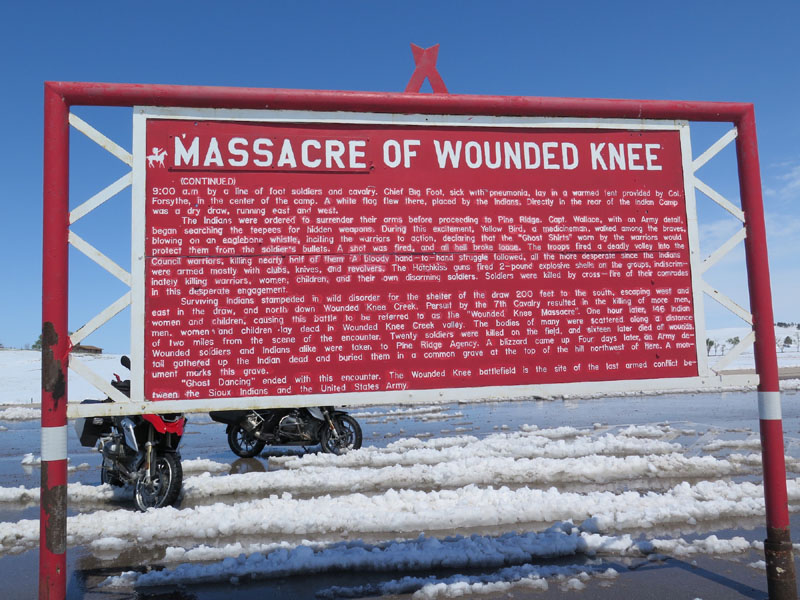
One telling detail glares on the roadside sign-something I noticed when Brutus and I were there nineteen years ago. The painted text has been touched up over the years, but the same title remained, Massacre of Wounded Knee, with the word "massacre" being a very obvious patch over something else, on both sides of the sign. Presumably the original caption was "Battle of Wounded Knee."
It was no battle...
Standing in that place and reading of the events of December 29, 1890, and subsequent days, brings on the same haunting chill as visiting the many Civil War battlefields in the MidAtlantic States, the World War One killing grounds in Belgium, or the Vietnam Memorial in Washington-not just so many individual ghosts, but the dark pall that is humanity's worst curse-faceless, impersonal murder.
Just as Michael and I were putting our gloves back on and preparing to ride away, a massive old GMC Suburban full of Native youths pulled up beside us. A young woman got out and stepped through the slush to me, clutching a hoody around her tattooed neck against the chill. She asked if we could "make a donation."
I said, "A donation to what?"
She said, "Gas."
I smiled at all that might have meant, and all it did mean, in this modern world and the ancient one of those youngsters' ancestors. I turned to my tankbag and dug out a twenty for her.
As they drove away, Michael asked, "What was all that about?" When I told him, he said, "Nice trick-just after you read all that horrible stuff and the white guilt is fresh, they hit you up!"
I said, "At least she didn't say, 'God bless you,'" and he laughed at that.
Around my home in Westside Los Angeles panhandlers often stood at the long red lights leading onto the Pacific Coast Highway. I always liked to help them out-never understanding how colder hearts could fail to see it was mental illness that put them there, not laziness. When I call over the unfortunate one and hand over the bill, if they give me the "God bless you" line, I shake my head while saying, "This has nothing to do with God-it's between you and me."
Sometimes they are taken aback, but one guy I encountered a second time, and as he started to say it, I raised a finger. He smiled wide and said, "I remember-'just between you and me,' right? I like that."
I smiled back and said, "I like it too."
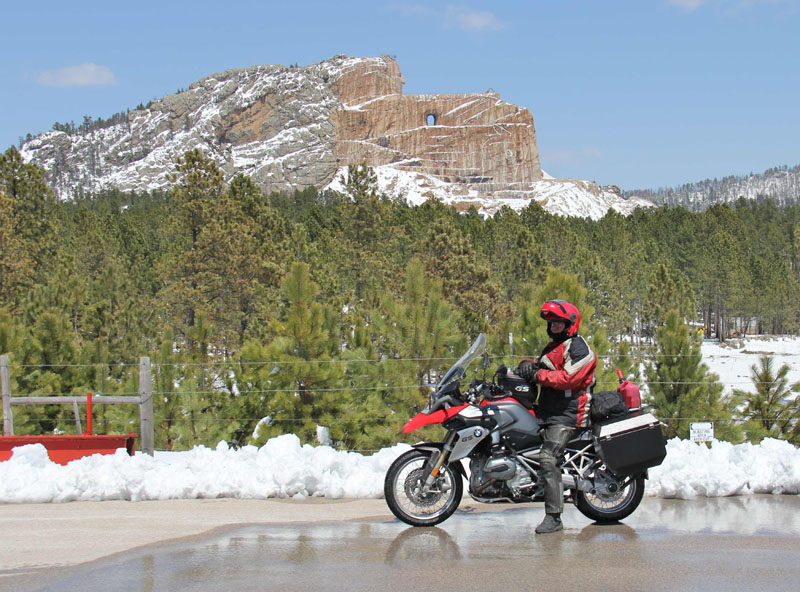 |
Crazy Horse in Progress |
After a brief stop at Wind Cave National Park (no time to visit the cave, but enough to collect the passport stamp), we rode on through the snowy hills, now dotted with pine trees, to the Crazy Horse Memorial. It was begun in 1948 with the grandiose ambition of becoming the world's largest sculpture, and has been funded only by private donations. It is fittingly located in the Black Hills, which had been promised to the Sioux by the American government "forever"-until gold was discovered there.
Since Brutus and I had paused for a quick look at the Crazy Horse Memorial in our "headlong flight" back in 1997, the face has been completed (top right profile). Sometime in the distant future the work will reveal his horse and pointing arm-which some elders claim is an obscene cultural insensitivity, equivalent to George Washington raising a middle finger on Mount Rushmore.
Which, fittingly, was our next "roadside attraction" that day.
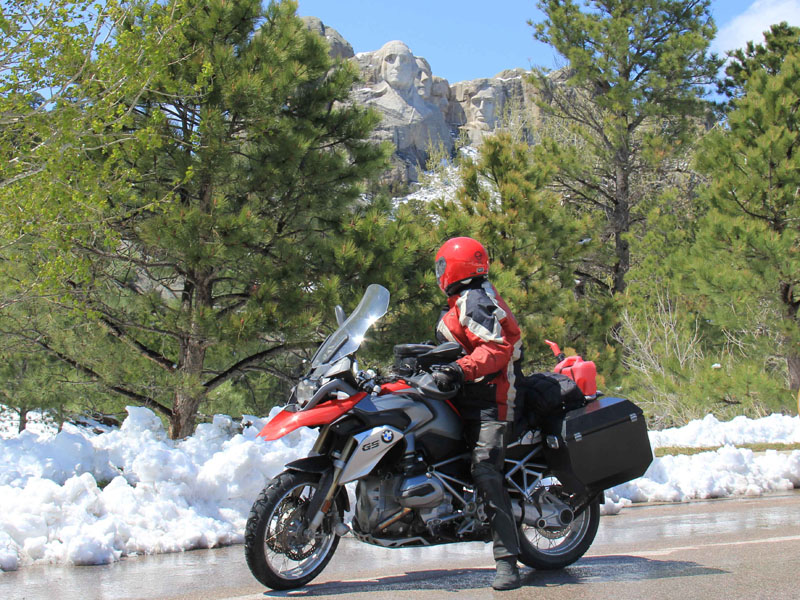
Our journey had been roughly northward so far, but after pausing to marvel at that truly monumental array of presidential faces (once again decoratively laced with snow), we turned east and looped under Rapid City and headed for Badlands National Park. The term "badlands" sometimes refers to areas where nothing grows, or where there is no water, but in this case came from the difficulty of getting the pioneer wagon trains through the area. I thought of their struggle often as I looked around at the landscape we rode through. Without roads, they would be very bad lands indeed.
Shortly after the opening photograph was taken, showing the wide-angle view, we saw some huge dark masses among the snow-patched grasslands. Four bison were grazing along the road, two of them right on the narrow strip of gravel and dirt. I stopped and put my feet down, thinking. They were ornery beasts, and huge (up to 4,000 pounds), and I wasn't sure how to proceed. What if they were a bull and his harem, and my approaching motorcycle became a "red flag?" I would have nowhere to ride or run from a charging bull.
Straddling the bike, I waved Michael alongside and said, "I'll ride through and make them mad-then you follow and I'll film the results!"
He made one of his droll "oh, ha ha" faces, and I said with icy scorn, "Don't worry-it's not mating season."
I went ahead, slowly, keeping my distance as much as I could. Fortunately there was no charging, but one of them started gallumphing up the road ahead of me. I tried to stay back and far to the road's edge, but it kept going for the longest time-me thinking, "All it has to do is stop and I'm crashing into a 4,000-pound wall." To my relief it finally humped off into the grass and snow.
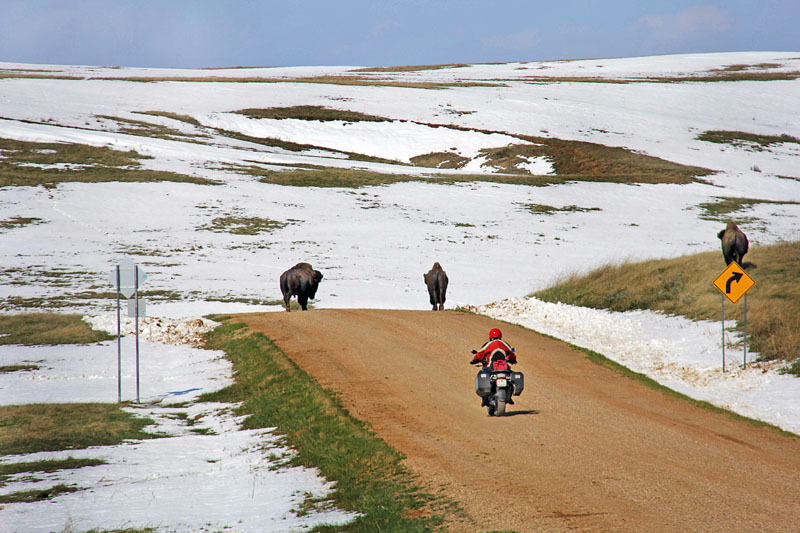 |
"I'll Go First!" |
Meanwhile, as Michael and I rode among the snow-covered "via points" and exciting wildlife that day, stopping often for photographs-especially through the unique landscape of the Badlands-Dave was driving the bus up through the middle of Nebraska to the lower middle of South Dakota. Assuming Michael and I accomplished all our missions, we would meet Dave at a dot on the interstate called Murdo. Michael and I would sleep aboard while Dave carried us a few hundred miles east to Sioux Falls. From there we could unload the bikes again and ride to the show in St. Paul.
The short version is that the day's journey went as planned (though we arrived at the Badlands visitor center twenty minutes too late and I couldn't get the passport stamp-but that was a minor disappointment). After over 500 miles and almost twelve hours of riding, Michael and I were safe and warm on the bus, toasting the day's hardships and rewards with Macallan 18. I've said it before and I'll say it again, "Magic happens-but it often requires some planning." And how.
The notion of "planned magic" segues very nicely into the frame story for these journeys-Rush's fortieth anniversary tour, or "R40." Because if there's anything a band wants to deliver to their audience as often as possible, it's magic. Even to aim for that elevation definitely takes some thought. The tour was born at a meeting I had with the Guys at Work and manager Ray in Toronto in early November-when I agreed to three months of touring and thirty-five shows. The work of planning those shows built with ever-increasing intensity for five months.
And "building" the show is how it started to feel, as we worked on the concept for a reverse-chronology presentation, employing the skills of many artists in theatrical staging and video arts (one of the pleasures of our profession is giving other artists the opportunity to do their best work). Eventually our traveling circus would fill eleven trucks, and carry sixty-two people in five buses, two motorcycles, and one chartered jet.
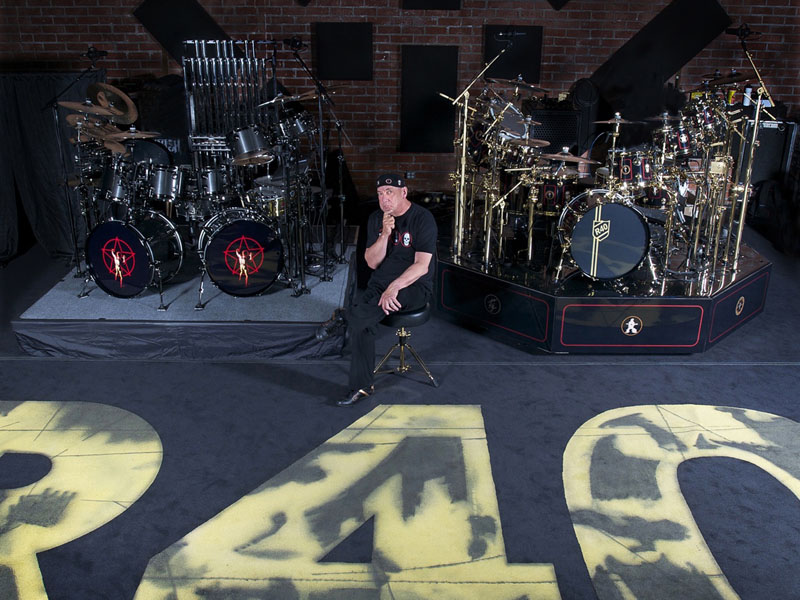 |
So I Had This Idea... |
Right from that first November meeting song suggestions rocketed among the three of us. We needed to narrow down a list for production reasons, and for us to be prepared to play them. We agreed fairly easily on ones we could retire for a while, often those we had performed recently, and the "indispensables" (fans know what they are!). We dredged up a few discoveries from the past, like "How It Is" from Vapor Trails (2002), which we had never played live, and "Jacob's Ladder" from Permanent Waves (1979), unplayed since that tour-a mere thirty-five years ago!
As I saw the way the setlist and production were growing, and listened to some of the songs from the late '70s we were considering, I had a whimsical thought that first triggered a smile, then an affirmative nod of my head. "Yeah. Gotta do it."
What if in addition to using the current iteration of my "modern" setup, during intermission I switched to a replica of the black-chrome Slingerlands I had played in the late '70s? Double bass drums, open concert toms, bad ergonomics and all.
It seemed irresistible to me, and I was soon meeting with the artists and artisans at Drum Workshop to begin work on designing and building both sets. (Giving more details in this space would qualify as drum porn, but the full story can be found in the R40 tourbook. Available at your merchandising counters now.)
Starting at the beginning of March, I rehearsed on my own for a full month at my home-away-from-home, Drum Channel. (Best of all is the commute-fifty miles up and back on the Pacific Coast Highway every day in one of my old silver classics-alternating the DB5, the E-Type, and the Ghibli.) With longtime drum tech Lorne "Gump" Wheaton, we got the new gear sorted and I began playing along with the recorded versions of the songs-a little more, and a little harder, every day. By the second week when I was sweating through two sets of clothes, I knew I was "getting somewhere." At the end of the day Gump handed me an Advil gelcap to take before driving home, and even then I would stiffen up during that hour, and climb out with a groan. But as I always say, I hurt all over, not in any specific place, so that's okay.
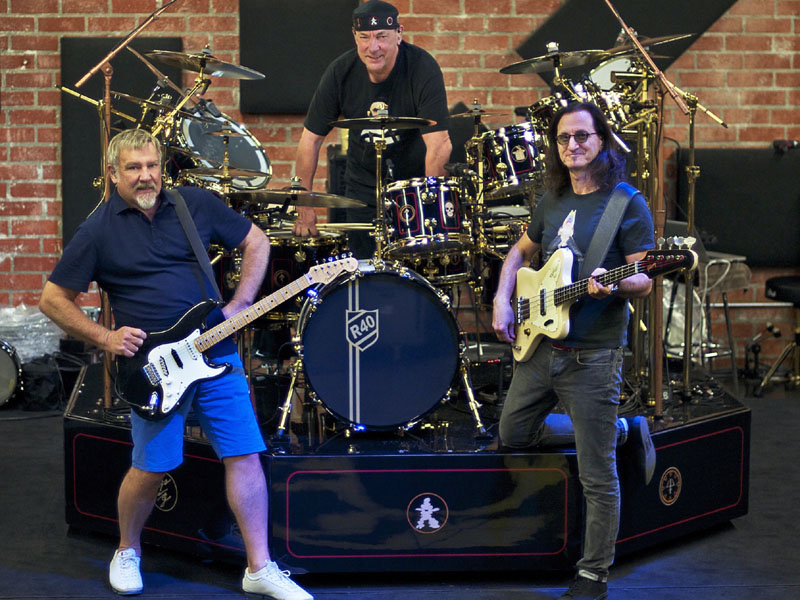 |
The Guys at Work |
During the same time the other guys were doing their "homework," and in April we got together for band rehearsals. Alex and Geddy had generously agreed to do them in Los Angeles this time, rather than the usual Toronto, allowing me to have more time at home. They are both grandfathers, while I am a "late-life dad," and "Uncle Alex and Uncle Geddy" understand that five-year-old Olivia likes to have her daddy around.
People laugh when I say I like rehearsing much better than performing, but it's true. While I understand the reality that I can't have one without the other, rehearsing offers all the same challenges and rewards without the stress and demands of working in front of an audience. And there is the bonus of being able to be at home mornings and evenings-have breakfast in my own kitchen, and sleep in my own bed. These small blessings cannot be appreciated without knowing their lack.
A journal note I made during band rehearsals was titled "My Metric Century," and under it I wrote, "Lucky days, these. PCH opening, traffic patterns, physical health, family equilibrium."
"PCH opening" referred to a long stretch of the Pacific Coast Highway on the way to Drum Channel that had been closed for months due to mudslides-it reopened two days before we started. "Traffic patterns" noted that my commute to the band rehearsal place was on one of the busiest freeways in the country, but good fortune had the heavy volume in the opposite direction each way. The first time I drove there on that notorious 405 I had the conscious thought, "That was way nicer than it had any right to be. What city am I in?"
The rehearsal place was part of a vast warehouse where many bands stored their equipment, and one entertaining pastime was watching all the different road cases cross the loading dock every day. Like a classic rock playlist, there was Def Leppard, Van Halen, Kiss, Fleetwood Mac, REO Speedwagon, Boston, and on and on. Some of the more obscure ones, like Billy Idol and the Black Crowes, I was just glad to see they had work...
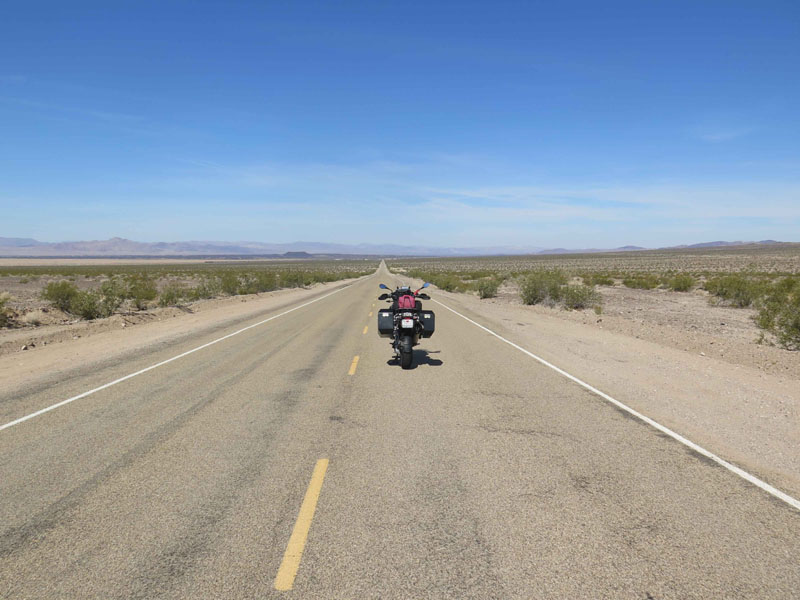
The above "ceremonial photograph" was taken on the morning of my departure from home to the production rehearsals and first show in Tulsa, Oklahoma. It is the latest in the Ghost Rider series begun in 1998, and with my motorcycle or car, I always like to repeat this setting-facing west on old Route 66 toward Amboy, California, with Roy's Motel and the Amboy Crater in the distance.
In the middle of that day's necessarily long freeway slog, I had allowed myself the luxury of crossing the Mojave by two-lanes, from Palm Springs to just north of Amboy, where I joined Interstate 40 for the rest of the day. (I-40 to R40-perfect.) That may have cost me an hour, but repaid me well in enjoyment.
Like the later "Badlands Express" ride in South Dakota, that first journey took some logistical planning. The first consideration was that I didn't want to fly from Los Angeles to Tulsa. My quality ratio of flying to road travel is if a journey can be done by road in less than a day, I'll do it that way.
In any case, a long motorcycle ride seemed the proper way to kick off a big tour, and this route was an especially sweet echo. Our thirtieth anniversary tour, R30, had also begun with a long ride on I-40, to rehearsals in Nashville. (I wrote about all that in Roadshow: Landscape With Drums: A Concert Tour By Motorcycle-available for purchase through this website now.)
But that 2,000-mile crossing had taken three days, and though this one was "only" 1,500 miles, to maximize time at home I needed to do it overnight.
So...strategy.
On the appointed day in late April, Dave set out with the bus and trailer from his home-base in Nashville. I had pulled the meeting point of Grants, New Mexico, out of my head as being roughly 750 miles from my house. From previous crossings I knew that distance was about "right"-to cover some miles without suffering too much. Dave and I agree that of all the cross-country interstates, I-40 is the most "interesting" (again, in quotes). The scenery is nice, changing from California desert (100 degrees at Needles) to the high-elevation pine forests around Flagstaff, then down to the redrock desert of New Mexico. The nostalgic remnants of old Route 66, which I-40 largely replaced, remain colorful and entertaining along the roadside in billboards and attractions.
Michael and I had ended up riding separately-because he was late showing up at my house, so I just left. (No fun standing in the driveway with all your riding gear on, straddling a bike that's left off not to disturb the neighborhood.) I figured we'd connect somewhere along that long highway, but we never did-Michael followed me into the truckstop at Grants to meet the bus a half hour behind me. The bikes were tied down in the trailer, and Dave drove us through the night to Elk City, Oklahoma. (Again, Chateau Walmart.) In the morning we unloaded the bikes and carried on another 300 miles, by my chosen back roads, to Tulsa, in time for the first production rehearsal that night. So even before the first show Michael and I had ridden over 1,000 miles.
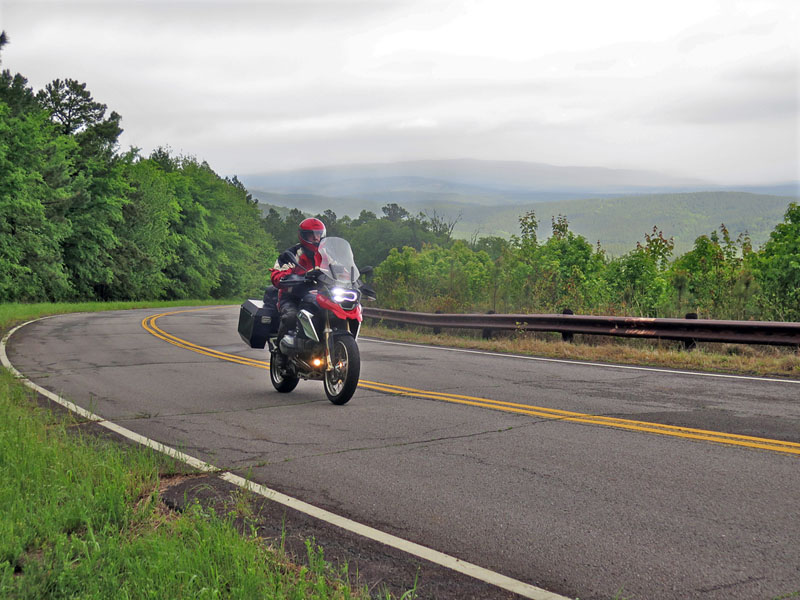 |
This Too is Oklahoma |
From time to time in my stories I have inserted a series of what I call "cliché buster" photographs: me on my motorcycle in the pastoral countryside of New Jersey, banking around a corner in Iowa, or railing through a ninety-degree bend in an Indiana cornfield. As one who has traveled a myriad of byways and landscapes in the United States, surely as widely as any living mortal, I have seen every stereotype, and every exception.
The above photograph was taken on the day of the first show, on Winding Stair Mountain, in the southeast corner of Oklahoma. The peaks behind are the Ouachita Mountains (surely where "Wichita" comes from as well), bridging Oklahoma and Arkansas, once part of the Appalachians much farther east. Winding Stair is an important scene in the novel True Grit, though replaced in the two film versions by Colorado and New Mexico.
Michael and I were returning from a day-off jaunt to Hot Springs, Arkansas, before the first show in Tulsa. Even this little side-trip had called for some strategy to make it possible, with Dave driving us south from Tulsa after the final rehearsal to McAlester, Oklahoma. (You know where we parked.)
But there was another mighty cliché buster during our stay in Tulsa. We were working there for a little over a week, rehearsing as we would be performing-every second night-so Carrie and Olivia joined me for a few days. One afternoon the two of them were out exploring the town (at first Carrie hadn't been impressed by the notion of spending a week in Tulsa, but we all ended up enjoying our time there very much), and I was looking out the window down at the pool. I was maybe ten floors up, and saw that the pool was filled with a crowd of burly white guys, many bald, but with luxuriant beards. Then I noticed a few pairs of them were obviously "cuddling" (there's no other word), one standing behind the other with his arms around him.
Short answer, they were "Bears"-a subset of gay men who identify by their size and hairiness. It turned out to be a formal gathering, called the "Green Country Growl" (the area around Tulsa calls itself "Green Country.") Like some of the other stories I've touched upon, there's much more to this tale-but the major deal is clear: It was happening in Tulsa!
I was surprised and delighted; others might be shocked and appalled. Nevertheless, it ...signifies...
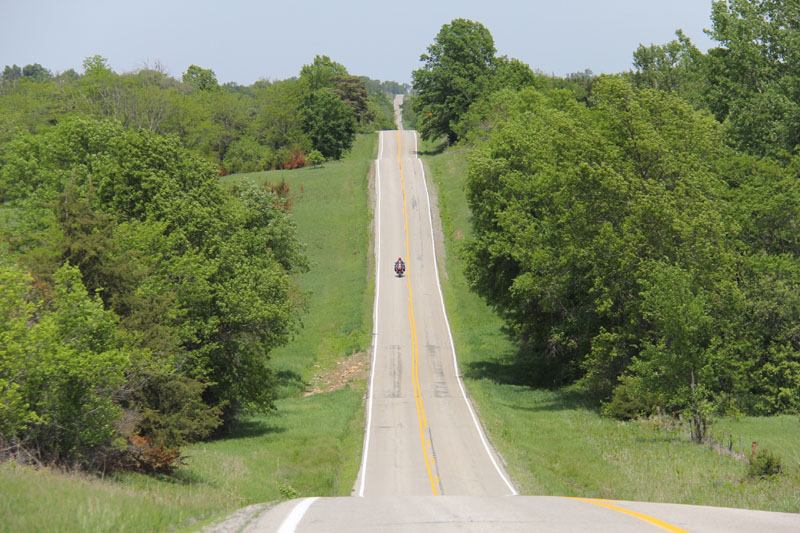 |
This Too is Iowa |
Considering these themes in words and pictures-the cliché busters of all kinds, from mountains in Oklahoma to Bears in Tulsa-an early title I thought of for this story was "This Too Is America." Yet we experienced moments in places that were absolute stereotypes, in the best sense.
Back in the early summer of 1997, on the Test for Echo tour, Brutus and I had also slept on the bus to Ogallala, Nebraska-coming from Denver that time, I think, on the way to a show in Dallas. That day we rode south through Kansas, with a pause at Dodge City (because it was there-and we grew up on "Gunsmoke"), and onward into Oklahoma. Late in the day the weather started to kick up, dark clouds looming in with gusty winds. We pulled over to put on our rain gear, and I took a photograph of Brutus holding his plastic rain pants as they were whipped out horizontal.
We took shelter in the town of Fairview, Oklahoma, at a small motel called the Heritage Inn. Parked in front of our doors, the owners' son, about ten, admired our motorcycles. He asked me where we had started that day, and when I told him Ogallala, he went wide-eyed and breathed, "Oh my!"
The way he said it, you knew that's how his mother talked.
Across the street was a diner called the Queen's Kitchen, and it was late evening when we sat down. A uniformed state trooper was dropping off a boy and girl with their mother (presumably the "Queen") before starting his shift. The boy was around ten, the girl maybe eight, and they were set to work refilling salt, pepper, and sugar containers at the other tables. As they worked, the girl sighed with fatigue and martyrdom, and the boy snapped indignantly, "You think you're tired, ha-ha-ha!"
Since that day, Brutus and I have repeated that line many times at the end of many long rides.
Here's the reference to Fairview in Roadshow, transcribed from a journal note when I was considerably more "lyrical" than my terse notes tend to be now.
And about those who bewail the loss of "regionalism" in America. Whether or not it's worth regretting, it's definitely still there-if those armchair anthropologists would get off the interstate! Away from the cities and beltways, away from the suits and logos and trailer-trash TV talk shows, there are still a million pockets of "Americana" out there, small-town gas stations and diners where you will meet hillbillies, aristocratic southerners, weathered ranchers, overalled farmers, solitary fishermen, burly loggers, apple-cheeked grandmothers, and friendly, decent folks. And a million landscapes, from snowy mountains and starkly majestic deserts to white picket fences and maple trees on Main Street.
Consider Roy's Motel on Route 66 in Amboy, California, the Queen's Kitchen in Fairview, Oklahoma, the Wheatleigh Inn in Lenox, Massachusetts, the Hammond Family Restaurant in Madison, Indiana, the Cowboy Café in Tilden, Texas, and "La Maison de Saucisse de Lac Artur," in Louisiana's Cajun country. All part of the Great American Theme Park.
After ten years, some of those name-checks no longer survive, but the truth of it remains. Always seeking that proof, when Michael and I were crossing Oklahoma this time I routed us through Fairview-the first time I had seen it since 1997-and was delighted to see that it remained an exquisite little western town (around 2,500 people), apparently thriving. The wide main street (yes, called that) was authentically wide enough to turn around a stagecoach (an important historical link), with full-size pickups angled into the curb on both sides.
The Heritage Inn was just down the street, looking exactly the same (maybe the "Oh my!" boy ran it now), though the Queen's Kitchen was gone. Well, it had been eighteen years. (When I did an online search for that diner, I found a couple of obituaries for ladies who had worked there, and my own above mention of it in Roadshow.)
A few days later, in another state, I was riding through another small town like Fairview and spoke the words out loud in my helmet, "Hello America-I've missed you."
Because this too is America.
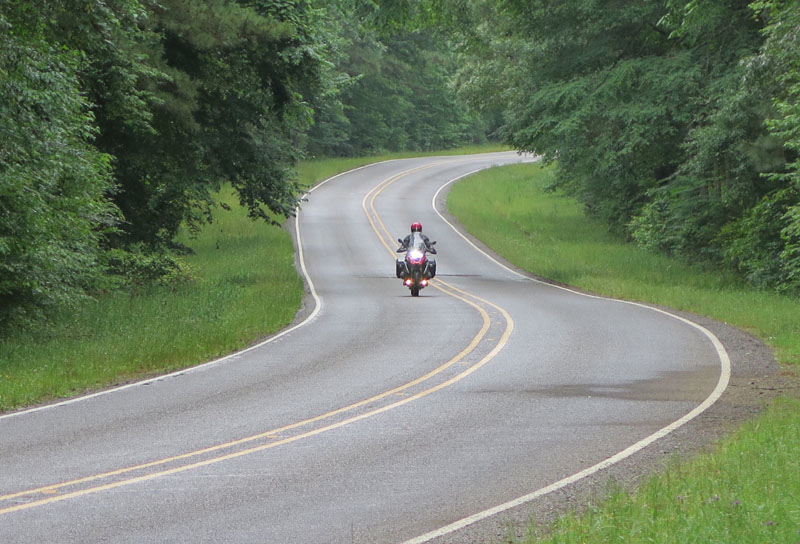 |
This Too is Texas |
"So we beat on, boats against the current, borne back ceaselessly into the past."
That wonderful ending line from The Great Gatsby applies so perfectly to this tour-I certainly do a lot of "beating" (and take a lot, too), and the show we are presenting goes back in reverse chronology, like the production around us, and the places Michael and I visit on days off.
"Boats against the current" can be translated to "bikes against the weather," as we had every kind there is, from desert heat to snow to torrential rains. The above photograph was taken on a rainy day in East Texas, the Piney Woods region, near our overnight stop in Nacogdoches. (Another destination chosen for its convenient location in an area I liked to explore-and for its name. The next evening at dinner before the show, when I was talking about it, Geddy said, "You just like saying that name." I nodded enthusiastically, "Yeah I do!").
The sheer volume of rainfall that day was greater than I have ever experienced on a motorcycle-all of our so-called waterproof gear was overwhelmed, and the roads were constantly awash. Though at least still navigable-it was just the beginning of a continuing deluge that a week later badly flooded that whole area of Texas. Talking to a lady at the motel in Nacogdoches that evening, I said I was thinking of parking the motorcycle and building a boat.
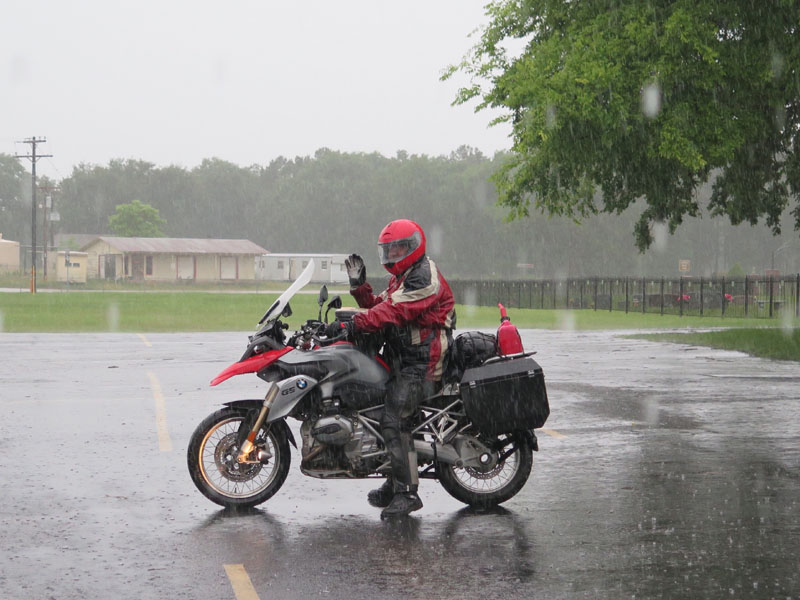 |
This Too is Nacogdoches |
In Oklahoma and Arkansas we had been menaced by thunderstorms, always carrying the threat of tornadoes. It occurred to me that we didn't have a "strategy" for that, and as Michael and I discussed it, I decided that if a twister was coming my way I would lay my motorcycle on its side, keep on all my protective gear, and crouch down beside its 600-pound bulk. Michael agreed that would be about the best we could do-and it felt good to have a "tornado strategy."
Journal note:
First priority night and day-look up weather.
Strange to be back glued to Weather Channel-satellite maps, live storm reports.
Tornadoes all around us for days.
Global weirding.
Those nights on the bus, or evenings in the motel, I was reading Head Check: What it Feels Like to Ride Motorcycles, by Jack Lewis. A veteran of America's Iraq "adventure" as an army staff sergeant (in a Psy-Ops company, of all things), Jack Lewis first came to prominence in Motorcyclist magazine, where I encountered his work. He is a fine writer-sometimes powerful and dark (a soldier returning to his Pacific Northwest home recalls Hemingway's "Big Two-Hearted River," only with motorcycling rather than fly-fishing as the vehicle), but more often he is light, witty, lively, and funny. From Head Check I picked up a term from his military career, "situational awareness," that certainly applies deeply to motorcycling-and not least to weather. (Like having a tornado strategy.)
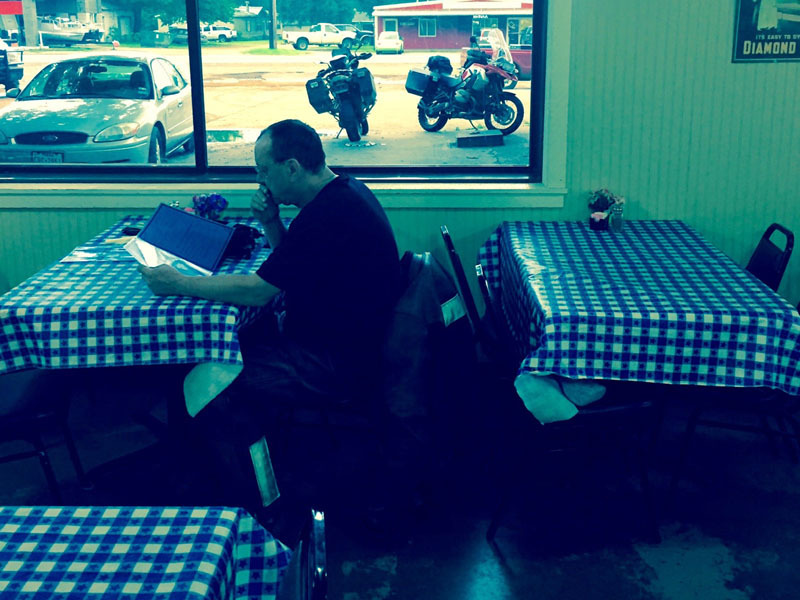 |
Roadhouse and Rain Poynor, Texas |
A few scattered journal notes jotted down at moments and places like this, or in the motel room at the end of the day:
Back to "What day is it?"
"Edge of seat" life of traveling, performing, keeping everything together-exhausting. Not boring, certainly-rewarding, even-so vital-but takes so much constant effort, and will.
Traveling is like performing, always on the ragged edge of "doability."
My arms weigh 200 pounds each.
Just faced a critical test. After long, hot (though *peaceful*) day, ending in a mighty flail of wrong GPS destination, then motel ridiculously complicated to get to. Looking in the mirror as I washed my face, thinking about all that, and asking existential question:
"Was it worth it?"
No hesitation-yes.
Farther south in Texas the enemy was heat and humidity-mid-nineties and slimy. In a story from the Clockwork Angels tour, "Adventures in the Wild West" (December 2012), I wrote about the devastation wrought by the oil frackers in the mesquite ranchland surrounding the little cowboy town of Tilden, a place I had admired since 1996. (Also name-checked in the above Roadshow excerpt.)
I didn't have the heart to go through there (or to rant on the subject again), but skirted the area to the south, just to have a look-see. On one long stretch of two-lane leading from nothing to nowhere, just horizon-to-horizon mesquite, I noticed ominous signs in federal red, white, and blue: "future interstate corridor 69." We began to overtake and pass trains of lumbering semis belching black smoke as they hauled crude metal tankers. Speeding up to get by them, our wheels shuddered over humps and ripples in the road's surface from their constant weight. Hordes of identical rigs crouched together in shambolic roadside lots, like giant robot caterpillars. Occasionally we passed massive installations of raw metal pipes and cylinders towering over the mesquite, and always miles and miles of security fencing-higher, tighter-meshed, and more forbidding than the window-pane mesh and barbed wire local ranchers used to favor. (Why does an oil operation need security fences? There's nothing to steal, and little to see, so what's to hide or protect? It's just suspicious.)
Usually I like to show "pretty" pictures, and would avoid unsightly traffic or industry, or crop it out, but on this one I left in the towering well-heads, utility poles, and tanker truck to the upper left, and the forbidding fence lining the far roadside. None of that was there even five years before.
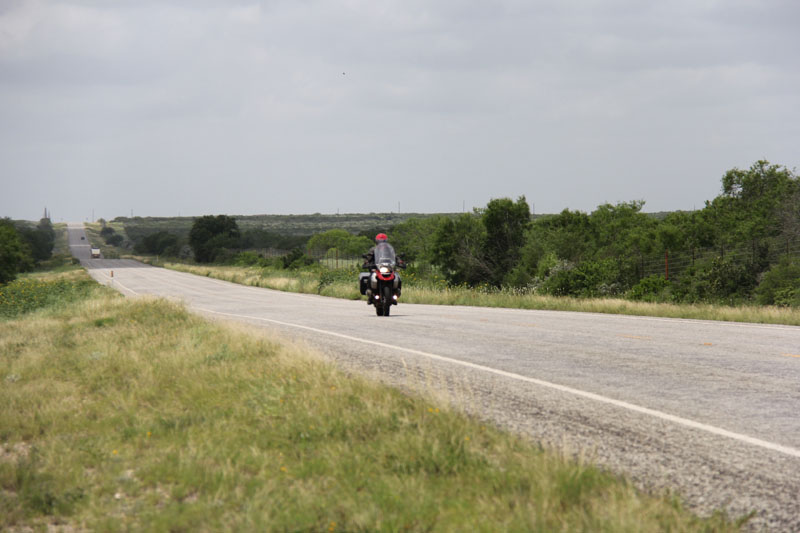 |
Mesquite Fracklands |
New Orleans was a welcome "intermission" in the run, in every way. Michael and I took three days off the bikes while I had a visit from Carrie and Olivia. We all enjoyed our time in that great city, eating well and wandering around the enduringly unique French Quarter (though apparently historically it's more Spanish than French). Olivia learned to imitate a deep Southern drawl from a cab driver from the airport: "He a cornbread, collard green, hamhock eatin' foo'."
It was also Olivia's first Rush concert, and she loved it. I had thought she might last a song or two, but she danced and air-drummed right to the end. Manager Ray arranged a "box" for them, high up over everything, and Olivia couldn't get over all the people.
"There must be two-thousand-and-eighteen people," she said.
Ray laughed and told her, "Actually there are about eleven thousand!"
Olivia looked puzzled, "Are they all here to see my dad and Uncle Alex and Uncle Geddy?"
When Ray assured her they were, she said, "That's too silly."
Then she wondered, "Do they know he's my dad?"
Ray laughed and said, "They probably do."
During intermission she came backstage and ran up to me, arms raised for me to pick her up. Still wearing her big red "ear defenders," she was so excited that she bounced in my arms.
"Daddy! It was great! I only didn't like the shipwreck" (rearscreen video in "The Wreckers," to her an echo of the dark beginning of Frozen, a movie she finds rightly unbearable) "and the explosion!" (Pyro-man Boom-Boom's fireworks in "Far Cry.")
I stayed in New Orleans with them for the day off after the show, then in the evening Dave drove Michael and me through the night to Tallahassee. He and I set off for a fairly pleasant ride on the backroads toward Tampa-until we had to get on the interstate near the city, and were exposed to the nightmare that is Florida drivers.
"Honey, don't let me commence!" is a fitting echo from New Orleans-a Truman Capote story about an old "madam" in Jackson Square who frequently begins her speeches that way.
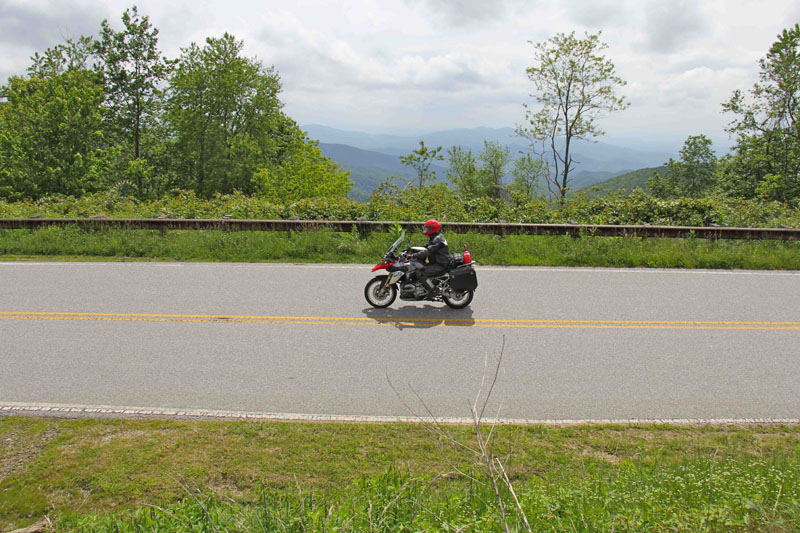 |
Cherohala Skyway |
Let us move on to the joy of riding in North Georgia, the Carolinas, the Virginias, and the neighboring corner of Tennessee. That's the heart of the Appalachian Mountains, and as good as East Coast riding gets.
A few tours ago Michael and I rode around North Georgia and neighboring North Carolina and Tennessee with friend Wes (Porcupine Tree guitarist and fine solo artist) and his wife Becca. Becca had grown up on motorcycles, riding behind her notoriously fast father, and back then Wes told us, "I usually just let her lead, and try to keep up." And that's what we did. (See "A Winter's Tale of Summers Past," February 2009, in Far and Away.)
Astonishingly, it was now seven years later, and in the interim Wes and Becca had welcomed son John Wesley Dearth IV (JWD4, or Jay) into the world. He was almost four now, and Becca had been on "maternity leave" from motorcycling all that time-these few days in the Southern Appalachians were her return to serious riding.
Back in 2008 we had all stayed at a fantastic little resort and campground devoted to motorcyclists, Two Wheels Only, in Suches, Georgia. It had closed a few years later, and when Michael and I rode by last tour I saw it was shut down and abandoned. However, a former customer, Bill, bought the property and reopened it with many improvements-such as (impossible not to pun on "Suches") these charming little cabins where we stayed this time.
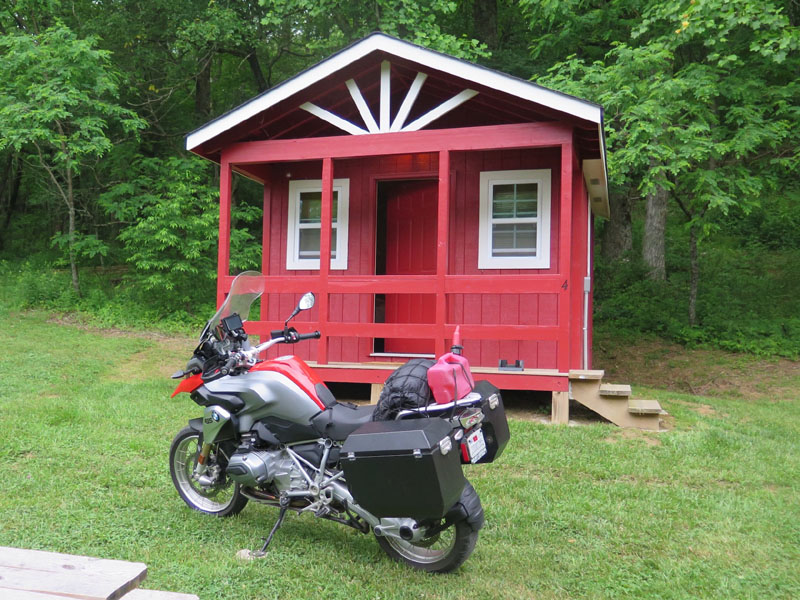
After the Tampa show Dave faced another all-night drive, to the north side of Atlanta. (Of course the "sleepers" also faced that all-night drive, which can never be as restful.) We actually parked right near the venue for the next show, and Michael and I rode out early to meet Wes and Becca in Suches. Wes told us they had been for a good ride the previous day, and he was glad to see that Becca had been "staying safe"-though once a sportbike rider had passed them, and Becca charged off after him and reeled him in. "Just to know I could do it," she said.
I had been prepared to follow her around once again, but she said she didn't want to lead. I asked her to write down a list of the roads, and we set off on a nice long loop of twisty two-lanes that took us to a favorite lunch stop of theirs in Tellico Plains, Tennessee. It was one end of the Cherohala Skyway, a scenic little road spanning Tennessee and North Carolina that, like the Blue Ridge Parkway or Skyline Drive farther north, is only there to be pretty. We made a number of photo stops along there, Michael wielding his manly camera to capture the three of us riding, along with the majestic scenery around us. At one stop he started complaining, "Maybe someone with a camera might take a shot or two of me?"
So a little farther on I pulled off the road and humored him.
(A journal note I made one evening in a motel:
Just realized the way I talk to Michael is the way I talk to myself. Nasty, withering, derisive, sarcastic-yet with occasional grudging approval. Like today thinking I had forgotten extra water, and cursing myself, then finding a bottle in my bag and thinking, "See? You're not so bad!"
Sometimes I do have to laugh out loud at myself.)
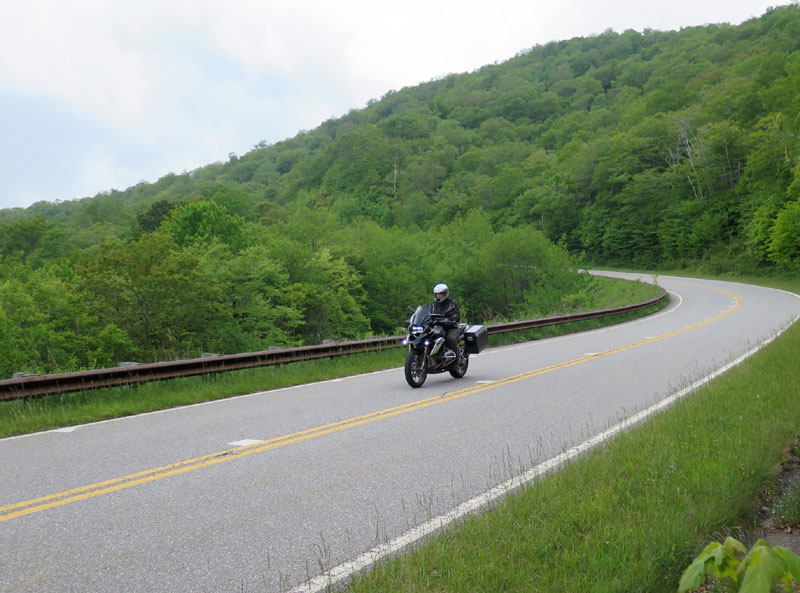 |
This Too Is Michael |
It sometimes happens that toward the end of a long ride something takes hold of me-like what Jack Lewis describes as "a horse that can smell the barn." It always happens on a challenging road, late in the day, and some of those rides have been unforgettable. Riding into Death Valley for the first time, under a full moon, was one of those-another happened in Tuscany, when Brutus and I had crossed the Alps from Austria and been held up with some bike trouble. By evening all of the Italians seemed to be off the road, and it was just me racing ahead of Brutus (he always sensed when I was "possessed," and just let me go). Winding through the exquisite countryside, framed in a supernatural golden light, my world shrank to the bike and the road. Absolute concentration engaged the technique of that interaction.
That day on the Cherohala, we still had a couple of hours to ride back to Suches, and dark clouds were bringing in the rain that was forecast for the evening. Once I was sure we had enough photos, I started "smelling the barn." I rode off and surrendered to that spell, that determined pace. I threaded the curves in a rapid rhythm, eyes like a ray on the apex and the exit, keeping everything smooth and quick. Occasionally I glanced in my mirrors and saw a single headlight behind-probably a sportbike rider, I thought, and I wicked up the pace a little-to keep him back there. Like Becca said, "Just to know I could do it."
Curve after curve, mile after mile, that light was still there, and only later did I learn that of course it was Becca. Wes said after, "I haven't seen her smile like that for a long time."
I asked him, "Is it a sin to dance with another man's wife?"
Wes laughed and said, "No, it's not!"
Although the newly-renamed Two Wheels of Suches was officially closed that night, we had a friend from our previous visit, Mimi. She was a schoolteacher who lived across the road, and in collaboration with Michael, she brought us dinner from a nearby town.
Through the evening rainshowers came and went, heavy and light, and between them fireflies twinkled in the trees. We had food and wine a-plenty, and laughter carried in the air.
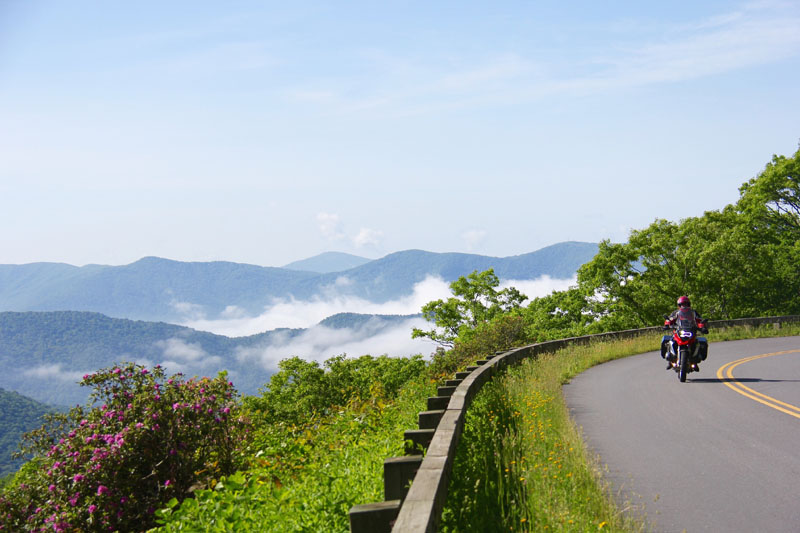 |
Blue Ridge Parkway |
In Atlanta we were joined by a "guest rider" from a couple of previous tours, Toronto percussionist and GS rider Richard Moore. I told him later we had given him a two-week motorcycle tour-in three days! After the Atlanta show Dave parked us in Greenville, South Carolina, and in the morning the three of us rode west toward Tennessee on some of the East's finest little roads-including the famous "Tail of the Dragon," Deals Gap, with "318 Turns in 11 Miles." As reported on previous visits, the celebrated place has become a circus for motorcycle and car clubs, but remains an undeniably wonderful and technically demanding stretch of road.
From there we cruised the Foothills Parkway (another sweet little road built only to be pretty, though less celebrated than the others), and back east through Great Smoky Mountains National Park to Asheville, North Carolina, and the Biltmore Estate.
Another long story short-it is a massive showplace of chateau-style (and I don't mean Walmart) mansion and gardens on 4,000 acres built for a Vanderbilt heir in the late 1890s, the Gilded Age. In America, it can only be compared to William Randolph Hearst's San Simeon in California. I first heard of the place from motorcycle magazines, because it was a popular setting for manufacturers to introduce new models-a glamorous backdrop amid spectacular riding country.
A fairly good hotel stands on another part of the grounds, and Michael and I have stayed there several times. (See that same story, "A Winter's Tale of Summers Past," for a charming previous encounter.) The last time, though, had left an unpleasant aftertaste, and I almost led us somewhere else that day. But I decided it had been the person, not the place.
And I was right. When we pulled up in the late afternoon, George the doorman welcomed us enthusiastically, saying he had been sure we would never come back, and how sorry he was about what had happened. Then the director of security, Victor, came out to share delighted greetings, and how terrible he had felt about it-for two years.
See, that time we had pulled our bikes under the front portico, and while we unloaded, Michael conferred the Order of the Palm upon George to let us keep the bikes there. We had done so before-there and at many other fine properties (I still treasure a photo of Brutus's and my bikes parked in front of the Hôtel Crillon overnight on the Place de la Concorde in Paris). We had also talked to Victor at the time, and they were fine with our out-of-the-way parking spots.
However, just as we were leaving our rooms for dinner Michael got a call from the manager, an unpleasant woman, saying we would have to move our motorcycles. We ignored her and went for a fine meal in the restaurant, only to find when we came back that she had recoded our doors-we had to wait (silent and fuming) while a red-faced bellman let us in to get our bike keys, then go out into the drizzle, in our dining clothes, to move the bikes.
George told me he said to her later, "You realize you just did that to a guy who has published five travel books?"
When I asked him what had happened to her, George smiled and said, with obvious satisfaction, "She's gone."
He mentioned that he was planning to attend one of our Toronto shows later that summer, and I quietly asked Michael to arrange some good tickets for him.
Next morning the saddle of each of our motorcycles was decorated with a red rose. That's a first!
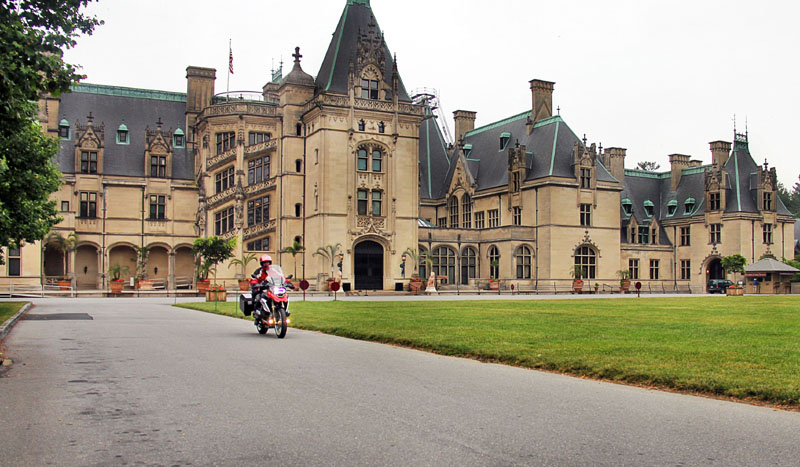 |
Biltmore House |
Michael and I teased Richard about having chosen to come out and ride with us for the only two nights when we were staying somewhere nice. On nights off we usually just settled into a modest motel somewhere, preferably with a nearby restaurant, and took what there was. From the Biltmore we rode to the following show in Greensboro (the band in a good groove now, with the performance consistent, though exhausting for us all). We had a night off before the final show of the run, at an amphitheater outside Washington, DC. Michael, Richard, and I spent that day on the backroads of Virginia and West Virginia, and I noted later that it provided every kind of road you could possibly want.
Switchback gravel? Single-lane paved? Third gear sweepers along the river? Logging roads? Picturesque little towns? Views of distant forested mountains? Sunny sky, wet roads?
That last was a result of our good luck in dodging the day's few showers, riding through a place that had just been rained on. The wet pavement steamed under the returning sun.
Altogether it was a pretty serious test of all kinds of riding techniques, from the loosest to the tightest, I might say. And always ready to adapt to surprises like the debris washed down into this one-lane hairpin in West Virginia.
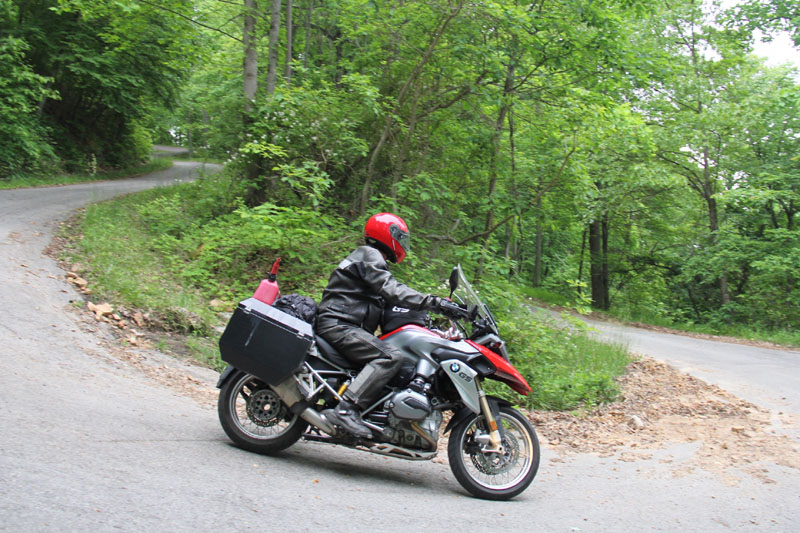 |
Dangerous Curves |
Best of all, the day ended at another unforgettable destination, the Homestead resort in Hot Springs, Virginia. Established in 1766, even before the country was, it is a place of elegance and splendor-the only destination in America where we pack a suit and tie for dinner. As at the Biltmore, Michael and I are "known" at the Homestead, because for years we have always stayed there on the way to the DC show. When Michael pulled up he was surprised when the doorman said, "We were expecting you today."
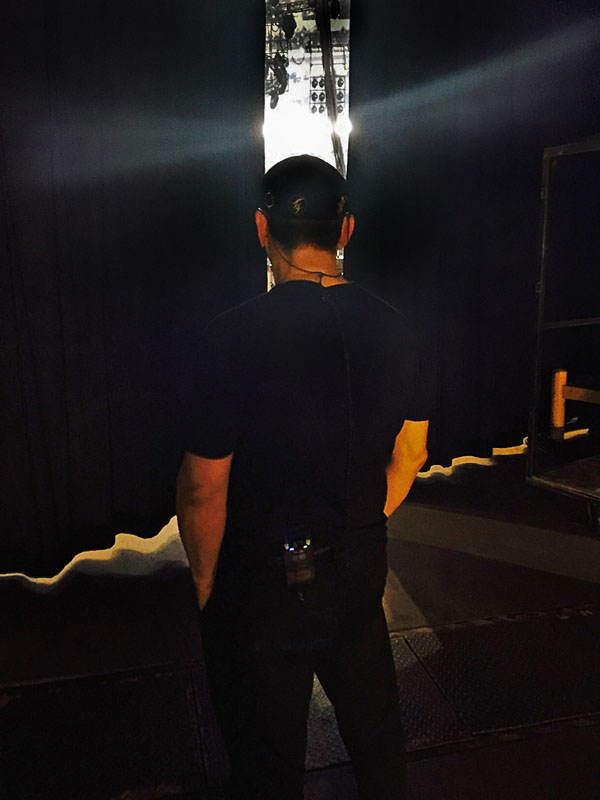 |
Awaiting Second Set |
The following day, when we were parked at the amphitheater in Bristow, Virginia, Richard said, in a tone that might have been admiring or just tired, "You guys are hardcore."
I presented him with one of the stickers we had been given by the BMW dealer in St. Louis, our "main guy" these days, for bikes and advice.
The sticker reads: "You Can Follow Me, But You're Not Going to Make It."
I said to Richard, "You made it."
And really, we all did. Michael and I made it through almost 7,000 miles of motorcycling, and the Guys at Work and me through twelve shows. Though for that last one at the Bristow amphitheater I was under attack from a bug that gave me stomach cramps, general malaise, and light-headedness-but everyone else seemed to have a good time.
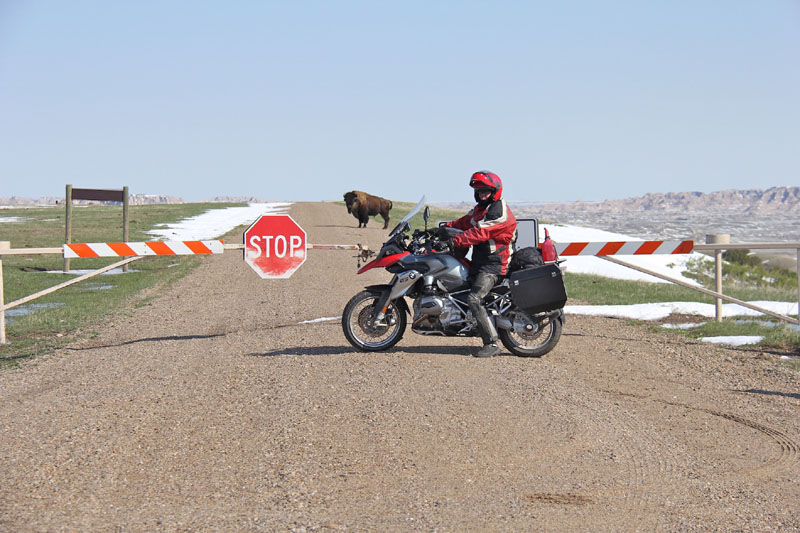 |
Bonus Picture |
Then a long, early flight the next morning for a painfully brief few days at home (just enough to write this long story-like Pascal, "I'm sorry I wrote you such a long letter; I didn't have time to write a short one") before a long flight back east, toward the next show in Columbus.
Back to the bikes, back to the drums, and back to the celebration of forty years of music-and my Metric Century.
So I beat on, bike against the weather, borne back ceaselessly into the past...